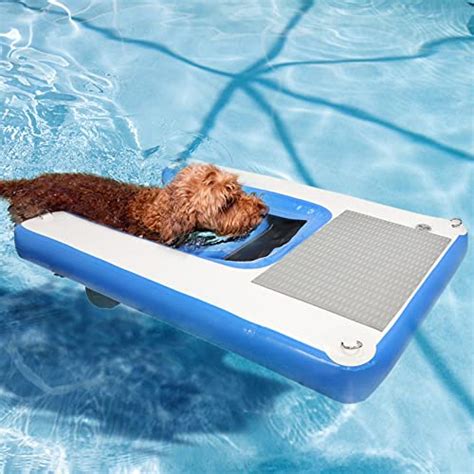Introduction
Dogs love water, but getting in and out of pools or lakes can be challenging, especially for puppies, senior dogs, or those with disabilities. A dog water ramp provides a safe and comfortable way for your furry friend to access the water, reducing the risk of injury or drowning and promoting a playful and healthy outdoor experience.

Benefits of a Dog Water Ramp
Increased Safety:
– Reduces the risk of drowning for dogs with limited mobility or coordination
– Prevents falls and injuries from jumping or climbing into the water
Improved Accessibility:
– Allows dogs of all ages and abilities to enjoy swimming and water activities
– Facilitates access for dogs with joint pain, arthritis, or other physical impairments
Enhanced Comfort:
– Provides a gradual and nonslip surface for dogs to enter and exit the water
– Reduces strain on joints and muscles, making it more enjoyable for dogs
Types of Dog Water Ramps
There are numerous types of dog water ramps available, each with its own advantages and disadvantages. Here are the most popular options:
1. Floating Ramps:
– Float on the surface of the water, providing access to pools or natural bodies of water
– Typically made from lightweight materials such as foam or polyethylene
– Ideal for dogs who enjoy swimming or spending extended periods in the water
2. Telescoping Ramps:
– Retractable ramps that extend and collapse for easy storage
– Made from durable materials like aluminum or plastic
– Offer adjustable lengths to accommodate different pool or water heights
3. Stationary Ramps:
– Permanently installed ramps that connect to the deck or patio of your pool
– Typically made from sturdy materials like concrete or metal
– Provide a more stable and secure access point
Choosing the Right Dog Water Ramp
When selecting a dog water ramp, consider the following factors:
1. Dog’s Size and Weight:
– The ramp’s dimensions should be appropriate for the size and weight of your dog
– Larger dogs require wider and longer ramps for comfortable access
2. Pool or Water Depth:
– The ramp should extend to the appropriate depth in the water to allow for gradual entry
– Floating ramps should have sufficient buoyancy to support the dog’s weight
3. Material Durability:
– Choose a ramp made from durable materials that can withstand regular use and weather conditions
– Consider the material’s slip resistance for added safety
4. Maintenance and Storage:
– Some ramps require assembly or installation, so consider the ease of setup
– If space is limited, opt for a retractable or collapsible ramp for convenient storage
Tips for Using a Dog Water Ramp
- Introduce your dog to the ramp gradually: Allow them to explore the ramp and become familiar with its purpose before attempting to use it.
- Provide treats or praise: Encourage your dog to use the ramp by rewarding them with treats or praise for successful entries and exits.
- Supervise your dog near water: Always supervise your dog when they are using the water ramp, especially if they are new to it.
- Maintain the ramp: Regularly clean and inspect the ramp for any damage or loose parts to ensure its safety and functionality.
FAQs
- How much does a dog water ramp cost?
-
Dog water ramp prices range from around $50 for basic floating ramps to over $500 for high-end telescoping or stationary ramps.
-
How do I install a stationary dog water ramp?
-
Installing a stationary ramp typically requires digging a trench, setting a foundation, and securing the ramp with bolts or concrete. It is recommended to seek professional assistance if you are not comfortable with DIY projects.
-
Can I build my own dog water ramp?
-
Yes, you can build a custom dog water ramp using materials such as wood, plastic, or aluminum. However, it is essential to ensure that the ramp meets safety standards and is sturdy enough to support your dog’s weight.
-
What is a good alternative to a dog water ramp?
-
If you do not have a dog water ramp, consider using a nonslip pet ladder or stairs to provide your dog with a gradual and safe way to enter and exit the water.
-
Is it safe for my dog to drink water from the lake or pool?
-
While it is generally safe for dogs to drink from natural bodies of water like lakes or ponds, it is not recommended to allow them to drink from swimming pools that contain chlorine or other chemicals. Tap water or filtered water is a better option.
-
How often should I clean my dog’s water ramp?
-
Regularly clean the water ramp with soap and water, especially after use in a dirty or muddy environment. Algae or bacteria can build up on the ramp over time, posing a health hazard to your dog.
-
What is a “doggie dock”?
- A doggie dock is a floating platform or dock specifically designed for dogs. It provides a safe and comfortable place for dogs to swim, play, and sunbathe. Doggie docks are often equipped with features like ramps, ladders, and shade covers.
Conclusion
Dog water ramps are essential accessories for pet owners who want to provide their furry friends with safe, comfortable, and enjoyable water access. By choosing the right ramp for your dog’s needs and following these tips and tricks, you can help your beloved companion have a fun and rewarding time in and around the water. Remember, always supervise your dog near water, and ensure that they have a life jacket if necessary. Happy swimming!
Additional Tips and Tricks
- Consider using a harness or life jacket for dogs who are not strong swimmers or are prone to anxiety in the water.
- Place the water ramp in a shaded area to prevent overheating or discomfort for your dog.
- Provide a hose or water bowl near the water ramp to allow your dog to stay hydrated.
- Train your dog to use the ramp safely and effectively by practicing with them on dry land before introducing them to water.
- If your dog is hesitant to use the ramp, try enticing them with treats or their favorite toys.
